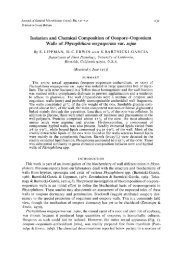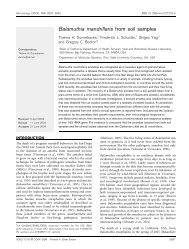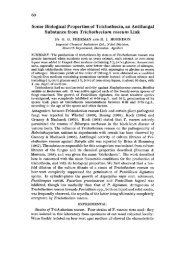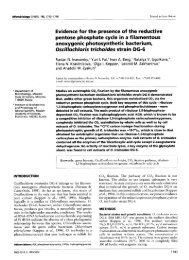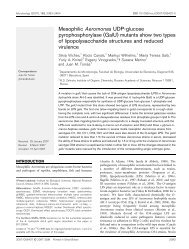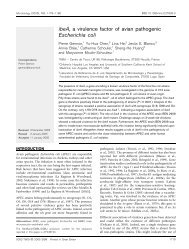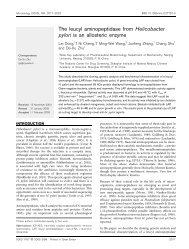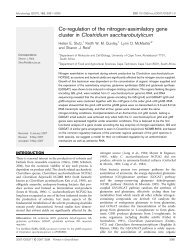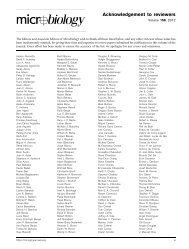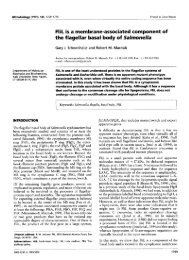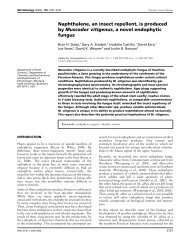The Characterization of Hyalochlorella marina gen. et ... - Microbiology
The Characterization of Hyalochlorella marina gen. et ... - Microbiology
The Characterization of Hyalochlorella marina gen. et ... - Microbiology
Create successful ePaper yourself
Turn your PDF publications into a flip-book with our unique Google optimized e-Paper software.
<strong>Characterization</strong> <strong>of</strong> <strong>Hyalochlorella</strong> <strong>marina</strong> =77<br />
RESULTS<br />
Morphological observations and developmental cycle analysis<br />
HyalochZorella <strong>marina</strong> individuals were colourless and produced creamy, yeast-like<br />
colonies on agar medium. On GDY agar the colonies were convex and <strong>gen</strong>erally<br />
smooth-margined (PI. I, fig. I) under a dissecting microscope. However, in some<br />
strains, older colonies (12 to 20 days) developed ‘watery’ edges (Pl. I, fig. 3) which<br />
resulted from the degradation <strong>of</strong> peripherally located organisms. As the colony<br />
grew older, the ‘watery’ region proceeded toward the colony centre, and at the end<br />
<strong>of</strong> about 25 days the colony was devoid <strong>of</strong> spherical cells. Wh<strong>et</strong>her this degradation<br />
was due to lysis or to synctium formation is uncertain, but the presence <strong>of</strong> walls<br />
radiating out from the colony centre into the ‘watery’ region seems to rule out<br />
lysis. Attempts to subculture pieces <strong>of</strong> the ‘watery’ edge were unsuccessful. In all<br />
strains, colonies with irregular haloes (Pl. I , fig. 2) were observed, but with an incidence<br />
<strong>of</strong> less than 0.5 %. <strong>The</strong>se haloes were formed by motile preautospores which migrated<br />
from the colony and subsequently became encased by a wall. This will be discussed in<br />
more d<strong>et</strong>ail below.<br />
One <strong>of</strong> the difficulties in the taxonomy <strong>of</strong> simple chlorococcalean algae such as<br />
Chlorella and Prototheca is their paucity <strong>of</strong> distinguishing morphological charac-<br />
teristics. <strong>The</strong> two characteristics which have been used in previous considerations <strong>of</strong><br />
Prototheca are size and shape (Pringsheim, 1963; Cooke, 1968b). Often, in giving<br />
size, authors have failed to specify which developmental stage was measured. Since<br />
sporangial size is directly related to the number <strong>of</strong> autospores produced and since<br />
the developmental stages b<strong>et</strong>ween the autospore and sporangium can be only<br />
temporarily distinguished, the only stage for which size d<strong>et</strong>erminations were felt<br />
valuable in this study was the newly discharged autospore. Measurements <strong>of</strong> 500<br />
newly discharged autospores <strong>of</strong> each strain growing exponentially on GDY liquid<br />
and agar medium showed a range in diam<strong>et</strong>er <strong>of</strong> 4 to 6.5 pm. and a mean diam<strong>et</strong>er<br />
<strong>of</strong> 5-5 pm. Immature sporangium diam<strong>et</strong>ers varied from 7 to 25 pm.; the smaller<br />
sporangia produced 2 autospores and the larger sporangia up to 128 autospores.<br />
<strong>The</strong> cell shape is spherical and occasionally ovoidal.<br />
<strong>The</strong> developmental cycle discussed below is based mostly on studies with strain<br />
66-6~, the type culture, and strains 66-5~, 66-8~, 68-30~ and 68-31~. Asexual<br />
reproduction took place by autospore formation. Following emer<strong>gen</strong>ce <strong>of</strong> the<br />
uninucleate autospore, the developmental cycle (Pl. 2 & Fig. I ) involved the immediate<br />
formation <strong>of</strong> a centric or eccentric vacuole followed by an increase in size with<br />
a concomitant increase in the number <strong>of</strong> nuclei by nuclear division. <strong>The</strong> immature<br />
sporangium was spherical and multinucleate. Cytokinesis occurred by multiple<br />
fission during which the multinucleate protoplast <strong>of</strong> the immature sporangium was<br />
segmented simultaneously into uninucleate protoplasts. Segmentation begins by<br />
invagination <strong>of</strong> the peripheral protoplast and central vacuole membranes ; both<br />
light microscope and electron microscope studies (Burr, unpublished work) showed<br />
the sporangial wall was not in any way involved. <strong>The</strong> uninucleate daughter protoplast<br />
(preautospore), devoid <strong>of</strong> a wall, was capable <strong>of</strong> motility similar to that <strong>of</strong> limax<br />
amoebae (Pl. I, fig. 12 to 14). As mentioned above, a small percentage <strong>of</strong> the colonies<br />
on each plate formed these motile preautospores. This percentage was greatly increased<br />
12-2



